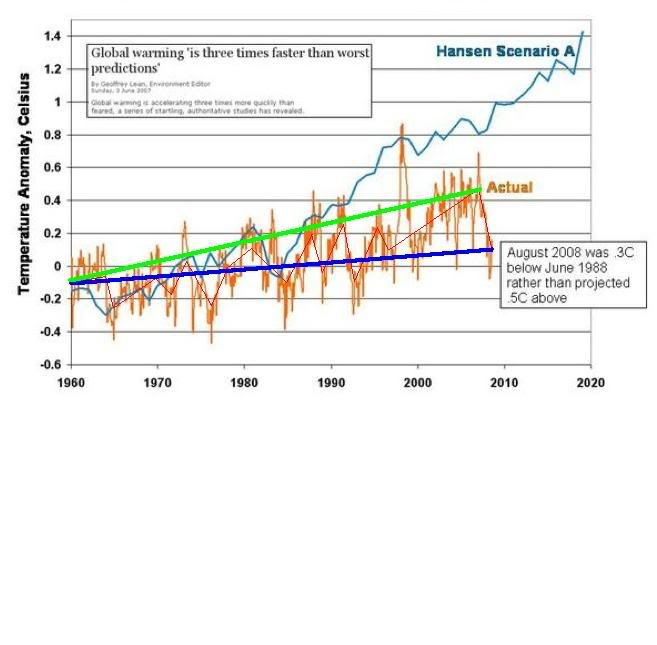jluetjen wrote:
So far no the AGW crowd has failed to accomplish the same. Sure CO2 and temperatures have increased. That proves nothing except that they appear to move in a similar fashion over the short term. The reason that this fails the common sense test is because if CO2 was the cause of global warming because of it's greenhouse abilities, then the change in temperature should always follow significant changes in CO2.
They do but you must also take into account the mitigating factors that are inherent in the source of the CO2.
jluetjen wrote:Not just in the geologically miniscule time frame of the last 100's or 1000's of years, but also across 10,000's and millions. The fact is that CO2 was 100's of time higher in the past,
Again, this is a
false arguement. the only time CO2 was dramatically higher was about 500 million years ago. Currently CO2 is at 385ppm average but in that distant past it was between 6000 and 7000ppm not even 20 times higher. To be 100 times higher it would need to be 38,500ppm which is highly toxic to most animals.
jluetjen wrote: for a long time, but yet the temperature only was about 10 degrees warmer flies directly in the face of your statement that a 2x or 4x increase in CO2 is going to cause our temperature to go up by 2 degrees.
Again you need to consider the source of the CO2 and the other factors involved. In this case, the major CO2 source was volcanism but volcanos spew more than just CO2.
Volcanic eruptions routinely contain:
Carbon Dioxide
(Volcanoes contribute about 110 million tons of carbon dioxide per year while man's activities contribute about 10 billion tons per year.)
Sulfur Dioxide
The greatest volcanic impact upon the earth's short term weather patterns is caused by sulfur dioxide gas which is converted to sulfuric acid by interaction with the sun's rays and stratospheric water vapor to form sulfuric acid between 15 to 25 kilometers altitude and last many years.
Without replenishment, the sulfuric acid aerosol layer around the earth is gradually depleted, but it is renewed by each eruption rich in sulfur dioxide. This was confirmed by data collected after the eruptions of El Chichon, Mexico (1982) and Pinatubo, Philippines (1991), both of which were high-sulfur compound carriers like Agung, Indonesia.
Chlorine
Chlorine gas can negatively effect the earth's environment by destroying ozone.
Fluorine
Which can condense in rain or on ash particles and cover grass and pollute water sources with excess fluorine. Animals that eat grass coated with fluorine-tainted ash can be poisoned by fluorisis, an affliction that eventually kills animals by destroying their bones.
And of course Ash, Pumice, Magma(lava), and rocks.
Some things to consider before interjecting this arguement again.
Autos, and cleaner energy sources produce cleaner CO2 and therefore fewer aerosols that mitigate the ammount of solar radiation reaching the surface. Therefore we receive ample ammounts of the side of the equation which blocks solar radiation from leaving the atmosphere. But, without the mitigating side which blocks transmission into the atmosphere.
The 1883 eruption of Krakatoa effected the global climate with just 1 major eruption which lasted from May 20 1883, on and off and on again, until August 28 1883 appx 3 months.
Global climate effects from the eruption:
In the year following the eruption, average global temperatures fell by as much as 1.2 degrees Celsius. Weather patterns continued to be chaotic for years, and temperatures did not return to normal until 1888. The eruption injected an unusually large amount of sulfur dioxide (SO2) gas high into the stratosphere which was subsequently transported by high-level winds all over the planet. This led to a global increase in sulfurous acid (H2SO3) concentration in high-level cirrus clouds. The resulting increase in cloud reflectivity (or albedo) would reflect more incoming light from the sun than usual, and cool the entire planet until the suspended sulfur fell to the ground as acid precipitation.
Global optical effects
The eruption darkened the sky worldwide for years afterwards, and produced spectacular sunsets throughout the world for many months. In 2004, researchers proposed the idea that the blood-red sky shown in Edvard Munch's famous 1893 painting The Scream is also an accurate depiction of the sky over Norway after the eruption.
This was just 1 eruption from 1 volcano during the period of our beginning of industrialization.
500,000,000 years ago there was more than just 1 volcano undergoing constant eruption spewing vast ammounts of CO2, SO2, Ash into the atmosphere causing CO2 levels to rise to 6-7000 ppm but also with ash and SO2 stopping much solar radiation from reaching the surface.
Volcanos spew more than just CO2 which blocks solar radiations escape to space, they also spew ash which blocks solar radiation from reaching earth to begin the heating cycle and Sulfur Dioxide which promotes cloud development increasing albedo and also acting to reduce initial solar radiation's enter into the cycle.
SO in the past, CO2 levels were nearly 20 times higher but the atmosphere was also filled with ash and SO2 which greatly reduced the ammount of heat entering the cycle to begin with.
ERGO highly elevated CO2 levels with moderately elevated temperatures.
